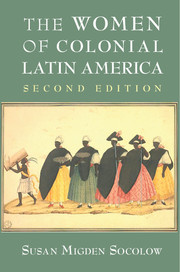Book contents
- Frontmatter
- Dedication
- Contents
- List of Figures
- Acknowledgments
- Introduction: Why Women?
- Chapter One Iberian Women in the Old World and the New
- Chapter Two Before Columbus: Women in Indigenous America and Africa
- Chapter Three Conquest and Colonization
- Chapter Four The Arrival of Iberian Women
- Chapter Five Women, Marriage, and Family
- Chapter Six Elite Women
- Chapter Seven The Brides of Christ and Other Religious Women
- Chapter Eight Women and Work
- Chapter Nine Women and Slavery
- Chapter Ten Women and Social Deviance
- Chapter Eleven Women and Enlightenment Reform
- Conclusion
- Documents
- Suggested Further Reading
- Index
- Plate section
Introduction: Why Women?
Published online by Cambridge University Press: 05 February 2015
- Frontmatter
- Dedication
- Contents
- List of Figures
- Acknowledgments
- Introduction: Why Women?
- Chapter One Iberian Women in the Old World and the New
- Chapter Two Before Columbus: Women in Indigenous America and Africa
- Chapter Three Conquest and Colonization
- Chapter Four The Arrival of Iberian Women
- Chapter Five Women, Marriage, and Family
- Chapter Six Elite Women
- Chapter Seven The Brides of Christ and Other Religious Women
- Chapter Eight Women and Work
- Chapter Nine Women and Slavery
- Chapter Ten Women and Social Deviance
- Chapter Eleven Women and Enlightenment Reform
- Conclusion
- Documents
- Suggested Further Reading
- Index
- Plate section
Summary
Gender is crucial to individual identity and, in all societies, to the roles individuals will play and the experiences they will have. The position of men and women in any society is a social construct, not a natural state. Each society and every social group has a culture that defines the roles and rules of masculinity and femininity; by conforming to these definitions, an individual becomes a “legitimate” man or woman.
The goal of this book is to examine these roles and rules and thus understand the variety and limitations of the female experience in colonial Latin America. One overarching limitation in both Spanish and Portuguese America was the existence of a patriarchal social organization. In the New World as in the Old, a clear sexual hierarchy placed women below men. By law and by tradition, men held the lion’s share of power in government, religion, and society. Furthermore, a man, particularly a father, was supreme within his family. Legally, all those living within the household were required to obey him.
In this society, women were dei ned i rst and foremost by their sex and only secondarily by their race or social class. In many colonial documents, the lack of attention to women’s race and class suggests that these attributes were malleable. Sex was not. Indeed, it can be argued that sex was the most important factor in determining a person’s status in society. Nonetheless, gender alone does not explain the various experiences of women in colonial Latin America. We must also keep in mind the importance of race, class, demography, life course, spatial variations, local economy, norm and reality, and change over time.
- Type
- Chapter
- Information
- The Women of Colonial Latin America , pp. 1 - 4Publisher: Cambridge University PressPrint publication year: 2015

